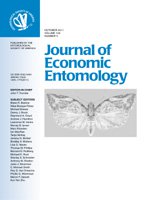Integrated pest management (IPM) offers guidelines to reduce spider mite (Acari: Tetranychidae) outbreaks by avoiding pesticides known to be harmful to the natural enemies of spider mites. However, in practice, these guidelines can be inconsistent in their effectiveness. The project examined whether California walnut (Juglans L.) growers, following IPM guidelines to avoid pesticides harmful to the natural enemies of spider mites, achieved lower miticide use. Significant statistical tests suggested that fields with harmful applications were 40% more likely to have a miticide application than fields without. Although the IPM guidelines achieved the goal of reducing miticide use, further analysis of other potential causal mechanisms behind outbreaks could strengthen the effectiveness of the guidelines, potentially increasing IPM adoption.
How to translate text using browser tools
1 October 2011
Does use of Pesticides Known to Harm Natural Enemies of Spider Mites (Acari: Tetranychidae) Result in Increased Number of Miticide Applications? An Examination of California Walnut Orchards
Kimberly P. Steinmann,
Minghua Zhang,
Joseph A. Grant
ACCESS THE FULL ARTICLE
It is not available for individual sale.
This article is only available to subscribers.
It is not available for individual sale.
It is not available for individual sale.

Journal of Economic Entomology
Vol. 104 • No. 5
October 2011
Vol. 104 • No. 5
October 2011
biological control
integrated pest management
secondary pest outbreaks
Tetranychidae
tree nuts




